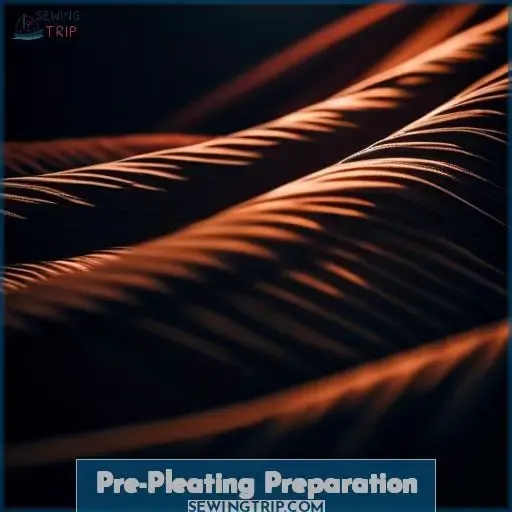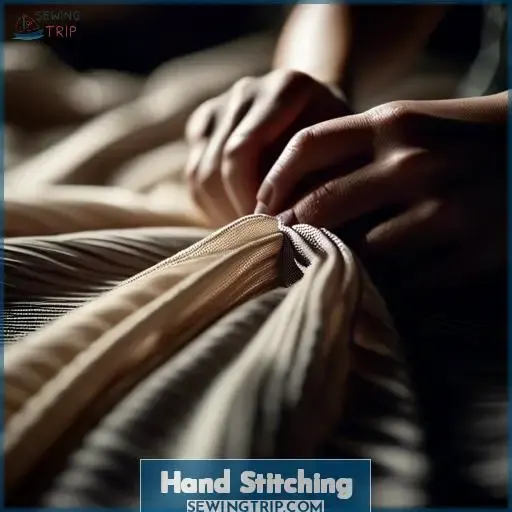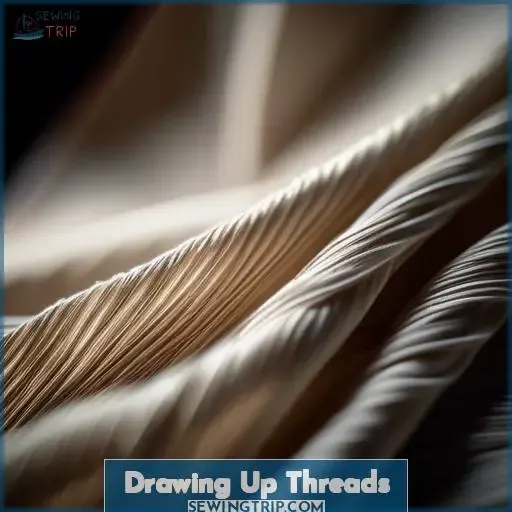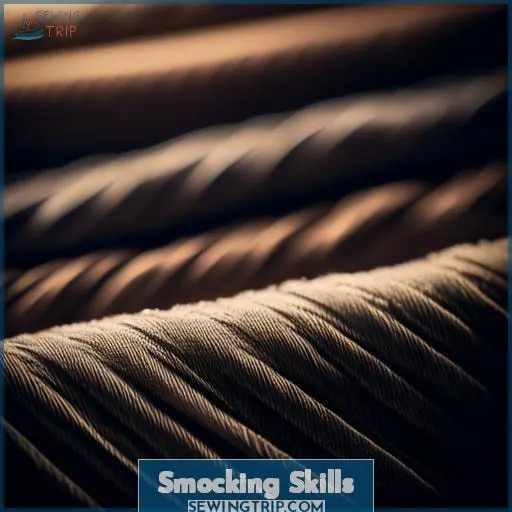This site is supported by our readers. We may earn a commission, at no cost to you, if you purchase through links.
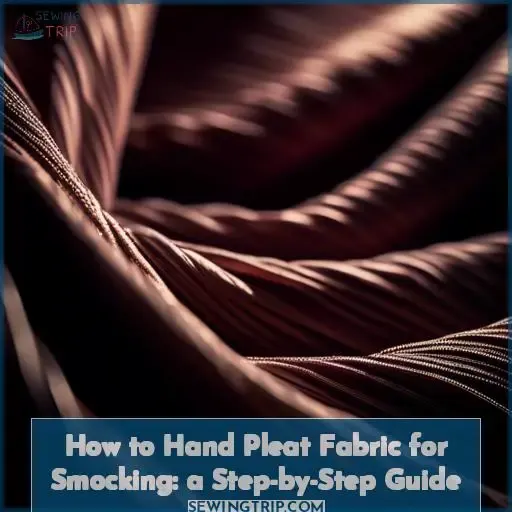 Discover the timeless art of hand pleating fabric for smocking, a technique that transforms simple textiles into intricately textured masterpieces.
Discover the timeless art of hand pleating fabric for smocking, a technique that transforms simple textiles into intricately textured masterpieces.
Whether you’re aiming to create a classic children’s garment or add a touch of elegance to adult apparel, mastering hand pleating is essential.
This guide will walk you through the process, from preparing your fabric with starch and a grid, to the final touches of securing your pleats.
Embrace the control and customization that hand pleating offers, and let’s delve into the meticulous world of smocking.
Yes, you can hand pleat fabric for smocking by following a step-by-step guide. This process involves creating small, even folds in the fabric to achieve the desired smocked effect.
Table Of Contents
Key Takeaways
- Precise fabric preparation is crucial, including starching and pressing the fabric for crispness, and creating a grid with a quilter’s ruler and wash-away marker for accurate pleating.
- Hand stitching requires careful attention to detail, using quilting thread and maintaining consistent stitch length and tension to prevent puckering while stitching along the grid lines.
- When drawing up threads to form pleats, aim for uniform spacing and even pleat size, managing fabric and thread tension to avoid puckering, and knotting off threads in pairs on each side for balanced tension.
- Explore various smocking stitches and designs, referring to smocking books and online resources for instructions and inspiration, and use smocking graphs to meticulously plan design layouts.
Pre-Pleating Preparation
Before you start hand pleating fabric for smocking, it’s essential to prepare your material properly. Begin by starching and pressing your fabric to ensure a crisp base that will hold pleats well.
Next, create a precise grid on the fabric using a quilter’s ruler and a wash-away marker. Mark horizontal lines 3/8 inch apart and vertical lines 1/8 inch apart. This grid will guide your stitching and ensure that your pleats are even and consistent.
Starch and Press Fabric
Begin by starching your fabric to add crispness, which simplifies cutting and sewing. Choose a starching method suitable for your fabric type—lighter starch for delicate fabrics and heavier for linens.
Press your fabric with care, employing techniques that ensure a smooth surface without distorting the grain. Next, create a precise fabric grid using a quilter’s ruler and a wash-away marker, ensuring lines are evenly spaced for uniform hand gathering.
When stitching, alternate between even and uneven running stitches based on your pattern—uneven for stripes or dots, ensuring the fabric is gathered consistently. Remember, the quality of your pleating sets the foundation for exquisite smocking.
Create a Grid Using a Quilter’s Ruler and Wash-away Marker
To create a grid for hand pleating, you’ll need a quilter’s ruler for precise spacing and a wash-away marker for temporary lines.
Start by starching your fabric to enhance its suitability for pleating. With your fabric ready, use the quilter’s ruler to measure and draw horizontal lines 3/8 inch apart and vertical lines 1/8 inch apart.
The accuracy of your ruler ensures even spacing, which is crucial for consistent pleats.
Choose a marker that will show up on your fabric but can be removed easily, ensuring the wash-away effectiveness won’t leave a trace. This grid creation sets the foundation for exquisite hand pleating, accommodating fabric considerations and allowing for meticulous control over each pleat.
Hand Stitching
When you’re ready to hand pleat fabric for smocking, you’ll need to arm yourself with quilting thread and a hand sewing needle.
This traditional technique allows for a high degree of customization and precision, especially useful for projects that require detailed work or are made from fabrics not suited for pleaters.
By stitching running stitches along the grid lines you’ve prepared, you can create evenly spaced pleats that are essential for the smocking process.
This method not only offers a personal touch to your textile projects but also ensures that your pleats are exactly where you need them, providing a perfect foundation for your smocking designs.
Use Quilting Thread and a Hand Sewing Needle
After prepping your fabric with starch and pressing, you’re ready to begin hand stitching.
- Select the right needle size for your fabric, aiming for one that allows smooth passage without distorting the fabric.
- Adjust thread tension to avoid puckering, ensuring even stitches that lay flat against the gridded lines.
- Maintain consistent stitch length throughout, which is crucial for the uniformity of hand pleating and the final appearance of your smocking.
Using a quilting thread and hand sewing needle, you’ll create the foundation for exquisite smocking by hand pleating along the grid lines you’ve drawn. This meticulous process allows for a custom fit and a personal touch to your textile projects.
Stitch Running Stitches Along the Grid Lines
To stitch running stitches along the grid lines for hand pleating, ensure even stitches for gingham and uneven for dots or stripes.
Stitch from the wrong side for uneven stitches, knot threads in pairs, and maintain pleat spacing.
This technique allows precise pleating on gridded fabric, enhancing control over curved areas and small details, a key skill in pleating fabrics without pre-pleated inserts.
Drawing Up Threads
Once you’ve stitched your running stitches along the grid lines, it’s time to draw up the threads to create your pleats.
Aim for about 15 pleats per inch, which will give you a dense and even texture ideal for smocking.
After pulling the threads to the desired density, secure your work by knotting the threads, ensuring your pleats stay in place and are ready for the next stage of your smocking project.
Draw Threads to About 15 Pleats Per Inch
Drawing up threads to achieve about 15 pleats per inch is a crucial step in hand pleating fabric for smocking. This process transforms your stitched fabric into a beautifully pleated piece, ready for smocking.
- Ensure even spacing: As you draw up the threads, aim for uniform pleat size. This consistency is key to achieving a professional look in your fabric smocking.
- Manage fabric and thread tension: Be mindful of the tension on both the fabric and the gathering threads. Too much tension can lead to hand fatigue, while too little may result in uneven pleats.
- Knot off threads carefully: Secure your pleats by knotting off threads in pairs on each side. This step prevents the pleats from unraveling and maintains the integrity of your work.
By focusing on these aspects, you’ll ensure your hand-pleated fabric is perfectly prepared for smocking, combining traditional techniques with your creativity and skill.
Knot Threads to Secure Pleats
Once you’ve stitched along the grid lines, it’s time to secure your pleats. Knotting your threads is crucial for maintaining fabric stability and pleat evenness.
| Step | Description |
|---|---|
| 1 | Pull threads to gather fabric, aiming for about 15 pleats per inch. |
| 2 | Check thread tension; it should be firm but not so tight it puckers. |
| 3 | Tie off threads using knot types that won’t slip, like square knots. |
| 4 | Ensure knots are on both sides for balanced fabric tension. |
| 5 | Adjust pleats by hand for uniformity before finalizing with knots. |
Smocking Skills
To enhance your smocking skills, it’s essential to consult a smocking book for comprehensive instructions and creative designs.
Whether you’re polishing existing techniques or embarking on learning smocking, these resources are invaluable. They provide step-by-step guidance and a variety of patterns to expand your repertoire in fabric manipulation.
Refer to a Smocking Book for Instructions and Designs
Once you’ve gathered your pleats, it’s time to dive into the world of smocking, where creativity meets precision. Smocking patterns and techniques can transform simple fabric into a masterpiece of texture and design.
- Explore smocking books for a comprehensive guide on various smocking stitches and designs. Books like A-Z of Smocking provide step-by-step instructions for beginners to advanced smockers.
- Experiment with smocking stitches such as cable, wave, and honeycomb to add depth and elasticity to your fabric.
- Incorporate smocking designs from plates available at resources like Children’s Corner Store, which offer a range of themes and styles.
- Utilize smocking graphs to plan your design layout meticulously, ensuring each stitch contributes to the overall pattern.
- Seek inspiration from creative sewing and smocking communities online, where you can find tutorials and share ideas with fellow enthusiasts.
By embracing these resources and techniques, you’ll unlock a world of textile design possibilities, enhancing your garments with the timeless art of smocking.
Brush Up on or Learn Smocking Techniques
Once you’ve mastered the basics from your smocking book, it’s time to dive deeper into the art. Smocking stitches, with their rich history, aren’t just functional; they’re a canvas for your creativity.
Whether you’re following traditional smocking patterns or experimenting with your own designs, the right smocking materials will make all the difference.
| Smocking Stitches | Smocking Designs | Smocking Materials |
|---|---|---|
| Cable Stitch | Floral Patterns | Quilting Cotton Thread |
| Honeycomb Stitch | Geometric Shapes | Gingham Fabric |
| Trellis Stitch | Animal Motifs | Iron-on Dots |
Pleating Without a Pleater
When you’re ready to add smocking to your fabric but don’t have access to a pleater, hand pleating is a reliable alternative.
You’ll start by creating a grid on your fabric using a quilter’s ruler and a wash-away marker, which will guide your stitching.
Then, with patience and precision, you’ll hand stitch running stitches along the grid lines to form the pleats, ensuring your smocking has a strong foundation.
Use a Quilter’s Ruler and Wash-away Marker to Create a Grid
Creating a grid with a quilter’s ruler and a wash-away marker is a pivotal step in hand pleating fabric for smocking, especially when a pleater isn’t available.
This method allows for precise control over the spacing and alignment of pleats, accommodating various fabric types and designs. By marking the fabric manually, you ensure that each pleat aligns perfectly with the fabric’s grain, enhancing the overall appearance and quality of the smocked piece.
The process involves drawing both horizontal and vertical lines on the fabric, using the ruler for accuracy. This grid serves as a guide for stitching, ensuring uniform pleat sizes and distances.
It’s a technique that harks back to traditional fabric manipulation methods, offering a hands-on approach to creating beautifully pleated fabric for smocking projects.
Hand Pleat Fabric by Stitching Running Stitches Along the Grid Lines
Once you’ve prepped your fabric with a grid, you’re ready to start hand pleating.
Now, dive into the heart of pleating: the running stitch. Follow the gridded lines, ensuring even spacing for a uniform look. For gingham, maintain an even running stitch, but for dots or stripes, opt for an uneven stitch, with more thread on the fabric’s wrong side.
This technique allows for precise pleating, essential for intricate smocking designs.
As you stitch, remember to knot your thread securely at each end, setting the stage for beautifully consistent pleats.
Frequently Asked Questions (FAQs)
How do you ensure even tension in hand pleating to prevent irregular pleats?
To ensure even tension in hand pleating, use your thumb to regulate tension. Keep stitches consistent and follow the fabric’s grid lines closely.
Can hand pleating be used effectively on all types of fabric, including very lightweight or heavy materials?
Navigating the fabric forest, hand pleating is like wielding a tailor’s compass, guiding through thick and thin.
While effective on a broad spectrum, very lightweight or heavy materials may require a magician’s touch, bending but not breaking under the craft’s spell.
What are the best practices for securing the ends of pleating threads to maintain the pleats during smocking?
To secure pleating threads for smocking, knot off threads in pairs on each side after stitching. This method ensures pleats stay intact during smocking, providing a sturdy foundation for intricate designs.
How do you adjust the pleating process when working with patterned fabrics to ensure the design remains aligned?
To ensure patterned fabrics keep their charm, dance with the design—align your stitches with the fabric’s grid, like gingham’s checks, for a harmonious display of precision and style.
What methods can be used to transfer smocking patterns onto fabric that has been hand pleated?
To transfer smocking patterns onto hand-pleated fabric, use a wash-away marker or tailor’s chalk to mark the design directly on the pleats.
Alternatively, create a template with the pattern and use a small running stitch to outline it on the fabric.
Conclusion
Delving into the art of hand pleating fabric for smocking challenges the notion that intricate textile design is out of reach for the home crafter.
With your fabric starched, pressed, and gridded, you’re equipped to create pleats with precision. As you stitch along your grid lines and draw up threads to secure your pleats, you’re not just making folds in fabric; you’re sculpting a textile masterpiece.

